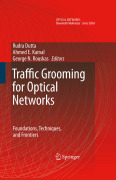
Traffic grooming for optical networks: foundations and techniques
Dutta, R.
Kamal, A.E.
Rouskas, G.N.
Traffic grooming is the name given to a family of optical network design problems that has attracted significant attention from both academia and industry in the last decade or so. The huge bandwidth of fiber optical networking is much larger than the typical bandwidth demands experienced by network service providers. This mismatch creates a need for multiplexing the low rate traffic demands into optical wavelength channels, but this requires costly electronic switching equipment, potentially offsetting the benefit of cheap optical transport. Traffic grooming refers to network design and resource allocation algorithms that can enable cost-efficient use of both network bandwidth and electronicswitching. Due to the increasing bandwidth of optical communication on the one hand, and the growing variety of traffic demand magnitudes on the other, traffic grooming has grown from a narrow research area to a mainstream requirement for real world practitioners. Covers fundamental and theoretical concepts related to traffic grooming as well as a wide range of existing approaches. Includes a description of various areas of research by the leading researchers in those areas. Presents the practical motivation, theoretical description, and extant techniques for traffic grooming in optical networks INDICE: Introduction.- Section 1 Enabling Technology and Standards.- Grooming Switches.- Control Plane Support for Traffic Grooming.- Mechanisms Enabling Grooming in First and Next Generation SONET/SDH.- Section 2 Theoretical Backround.- Complexity Theory for Traffic Grooming.- Traffic Models in Dynamic Traffic Grooming.- Hierarchical Traffic Grooming.- Section 3 Static Traffic Grooming.- Traffic Grooming in SONET Rings.- Traffic Grooming in Next Generation SONET/SDH Networks.- Large-Scale Hybrid Optoelectronic Networks.- Network Dimensioning and Provisioning Exact Approaches.- Network Dimensioning and Provisioning Approximate Approaches.- Section 4 Dynamic Traffic Grooming.- Dynamic Traffic Grooming Algorithms.- Scheduled Service.- Performance Models.- Section 5 New Directions/Frontiers in Traffic Grooming.- Protection Approaches for Survivable Traffic Grooming.- Multi-Domain Traffic Grooming.- Multicast Traffic Grooming.- Waveband Traffic Grooming in GMPLS Domains.
- ISBN: 978-0-387-74517-6
- Editorial: Springer
- Encuadernacion: Cartoné
- Páginas: 300
- Fecha Publicación: 01/03/2008
- Nº Volúmenes: 1
- Idioma: Inglés
